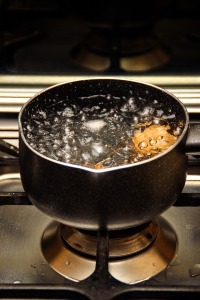
Food takes longer to cook at altitudes higher than 3,000 feet above sea level. The key factor is the decrease in air pressure. Lower air pressure drops the boiling point of water by approximately 1-degree Fahrenheit for every 500 feet in increased elevation.
Water at a lower altitude and temperature will boil more quickly. Then, at a higher altitude, food will take longer to become fully cooked and will not be as hot as it would be at sea level; it will cool off more quickly as well. With other cooking methods such as roasting food in an uncovered pan in the oven, normal sea level cooking times still apply, because the oven heat is not affected by lower air pressure.
Some foods may cook faster at higher altitudes in a microwave oven because the water in the food boils faster. This does not hold true, however, for meat, poultry, pasta, and rice. At sea level, a pressure cooker can cook food 30 percent faster than steaming, boiling, and braising.
At higher altitudes, cakes, breads, and other foods that contain leavening agents rise more quickly because gases produced by the agents spread out faster than at sea level. The loaves may collapse if the gases are removed before the proper temperature is reached, though. At high altitudes, most baking recipes can be adjusted.
In conclusion, the different temperature of boiling point is important to know because as the temperature increases at boiling point, bubbles of vapor start to form within the liquid and rise at the surface and the temperature of the boiling point is lower at higher altitudes.
[Source:
New York Times
]

